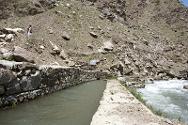Afghanistan: Taming a river brings light and livelihoods to a Panjshir community
10-06-2014 Feature
One of the main challenges facing the people of Andrasad, a village of some 530 households in the Panjshir valley, was not the lack of water; rather, it was how to tame the grey surging Shotol tributary that hurtled past their orchards and wheat fields.

The micro-hydro plant pictured here produces electricity for the village and its adjoining hamlets. ICRC/CC BY-SA 2.0 / J.Barry
Situated some two hours' drive north of the Afghan capital Kabul, the fabled Panjshir snakes through mountains whose peaks soar to 4,000 metres and more. The valley is a paradise of walnut trees and grape vines, of apple orchards and mulberries. In spring, the blossom on the fruit trees perfumes the clean mountain air.

From left to right: Baba Jan, head of disaster management for the Afghan Red Crescent Panjshir branch, Qari Fazalhaq, and Mullah Mohammad in discussion with their visitors
/ J. Barry / ICRC/CC BY-SA 2.0
The valley's entrance, however, is littered with rusting tanks and other military hardware, bitter reminders of decades of war, first against the Soviets, and later, when the Panjshir was the last bastion of the Northern Alliance, against the Taliban.
In Andrasad, as in many other villages along the valley, people live off the land. And although life is tranquil now, it is still hard. People grow wheat and beans, fruit and corn. Sheep and goats wander the mountain slopes, followed by scampering children or old men. The river sings as it tumbles past the mud-brick houses.
Sitting one recent morning in warm sunshine with a group of Andrasad's village elders, Qari Fazalhaq, a member of the local council, or Shura, and responsible for the community's finances, explained to four visitors one of the major problems facing his village, and how it had recently been solved.
"Although we have a lot of water," Mr Fazalhaq began, "It didn't bring us any benefit because the river flows too fast, and is hard to divert."
"Our apple and apricot trees suffered," admitted Amir Mohammad, a white-bearded elder, "and our almond and walnut trees suffered, too."
"Although we have a lot of water," Mr Fazalhaq began, "It didn't bring us any benefit because the river flows too fast, and is hard to divert."
In 2006, a scheme to divert water from the Shotol to irrigate the land and generate electricity in a micro-hydro plant failed when the diversion wall collapsed during a flood surge, a year after being built. Without the resources to repair it, the villagers in Andrasad, and its adjoining hamlets, saw their hopes of bringing electricity to their homes dashed. And their orchards remained dry.
Mr Fazalhaq, who happened to be an Afghan Red Crescent Society volunteer, decided to seek the organization's help when he learned, last summer, that it was supporting small, community-based cash-for-work projects with financing from its sister organization, the International Committee Red Cross (ICRC). He put together a proposal to build a new diversion wall in the traditional style, and presented it to the Red Crescent. Following an assessment, the project was approved.
"The scheme had two main benefits," explained Ghulam Muhaiudin Sayad, the ICRC field officer in charge of community programmes who was one of the four visitors sitting with the elders that day. "Firstly, by rebuilding the diversion wall in a better way and adding a linking canal, river water could be diverted easily to the main irrigation channel and from there into the farmers' orchards or fields. Secondly," he went on, "the diverted water would provide power to generate electricity through the micro-hydro plant that was part of the original scheme that failed."

The diversion wall and a short section of canal brought water to the main channel.
/ J. Barry / ICRC/CC BY-SA 2.0
Overseeing the building of the new wall was Baba Jan, head of disaster management for the Panjshir branch of the Afghan Red Crescent. The ICRC financed the project, providing the sand and cement and paying incentives for 25 days to the 25 villagers who did the work. The community's contribution was to collect stones and provide the labour force. The men also offered their services for an extra 10 days free of charge. The work began in October 2013 while the river was low, and ended a little over a month later.
"Electricity is one of the biggest benefits of the project that we now have," Mr Fazalhaq told his visitors as the elders clustered round.
"We spent years living in the dark," added Mullah Mohammad, one of the labourers who helped build the wall and linking canal. "But now we can see at night, and we can iron our clothes, and charge our mobile phones."
"We will get more fruit from our trees this year because we can water the orchards properly," volunteered white-bearded Amir. "And get better harvests, too."
Although taming the Shotol has brought improvements to the village, it is unlikely to bring about any fundamental change. Farming will remain the mainstay of people's lives, and although Andrasad boasts two schools, one for boys and one for girls, when they graduate the young will continue to leave home to study in Charikar, the nearest town, or in distant Kabul. Their parents will still work the land, as they have done for generations, selling fruit by the wayside up on the highroad during the season, raising sheep and goats, and, at night, gathering to gossip under the stars. Only now, pinpricks of light from every home will dance before them in the dark.

Villages in the Panjshir valley are surrounded by peaks that soar to 4,000 metres. ICRC/CC BY-SA 2.0 / J.Barry